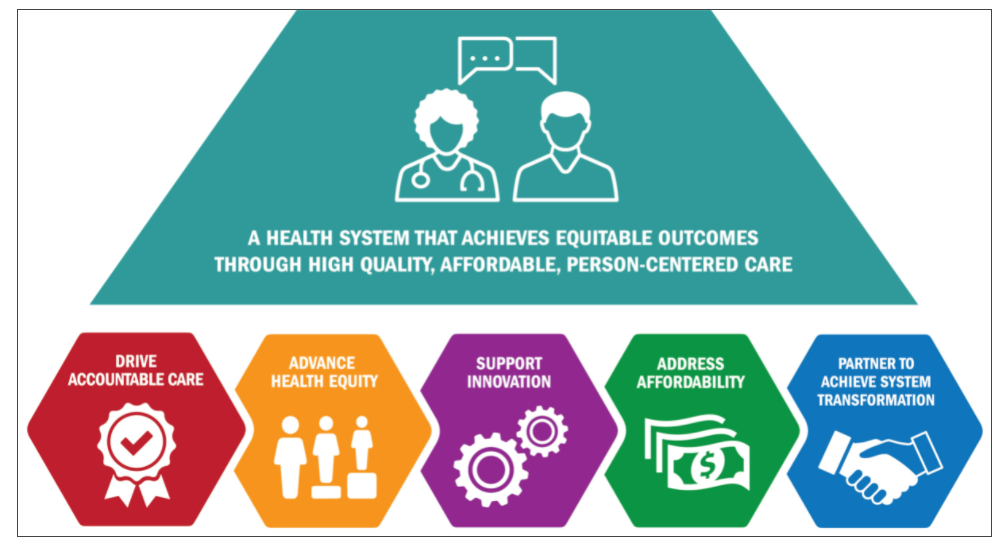The Innovation Center’s vision for the next decade is a health system that achieves equitable outcomes through high quality, affordable, person-centered care.
Health Affairs Blog
Chiquita Brooks-LaSure; Elizabeth Fowler; Meena Seshamani; Daniel Tsai
AUGUST 12, 2021
Citations:
- Don Berwick, a former leader of the Centers for Medicare and Medicaid Services (CMS)
- Rick Gilfillan, Innovation Center Director
In 2010, the Affordable Care Act (ACA) created the Center for Medicare and Medicaid Innovation (Innovation Center).
The Innovation Center aims to create a more value-based system that reduces spending while preserving or enhancing quality of care.
As staff who worked on drafting and implementing the ACA and on innovations at the state level, we knew that rising health care costs posed a threat to Medicare’s financial sustainability, state Medicaid budgets, and household spending, and we also knew that our fragmented and siloed health system was not delivering the best care for the money we were spending.
We knew that we needed innovative solutions to bend the cost curve and ensure that every American had access to high-quality health care.
Ten years later, President Biden has come into office on a promise to expand access to health care and lower costs.
We have an opportunity to reflect on the Innovation Center’s past accomplishments as well as its future.
After launching more than 50 alternative payment models that reward health care providers for delivering high-quality and cost-efficient care, the Innovation Center has learned a great deal and is ready to build a stronger and more sustainable path forward.
Beneficiaries, providers, and other stakeholders are encouraged by the work of existing models and are calling on the Innovation Center to leverage those lessons.
Don Berwick and Rick Gilfillan, a former leader of the Centers for Medicare and Medicaid Services (CMS) and an Innovation Center Director, respectively, recommended ways to connect the Innovation Center’s agenda to CMS’s and U.S. Department of Health and Human Services’s (HHS) goals for improving health and health care delivery; they also offered proposals to improve the Innovation Center’s model performance through, for example, changing the way Innovation Center models set payment and financial goals and measure quality.
And MedPAC, a non-partisan legislative branch agency that provides the U.S. Congress with analysis and policy advice on the Medicare program, is considering draft recommendations related to the Innovation Center’s work that support a streamlined and more harmonized portfolio of models.
As now incoming leaders at CMS under a new administration, we have taken stock of lessons learned and begun to chart a path for the next ten years of value-based care.
In undertaking this review, we concluded that we need a shared vision of the health system that we are collectively striving toward; we explicitly acknowledge health equity as a central goal for this vision.
This focus aligns with President Biden’s day-one executive order charging each agency within the Administration to advance racial equity and justice for underserved communities.
We asked ourselves how the Innovation Center is driving meaningful change to make the health system better for all people, including those who have not had reliable access to health care previously, using the levers of Medicare, Medicaid and CHIP.
And, we challenged ourselves to articulate how success should be measured beyond what is required in the law. What does the health system of the future look like? We received considerable feedback on what the vision for the ideal health system could look like and the role that CMS and the Innovation Center should play.
Additionally, we looked at existing Innovation Center models in a fresh light to ask what they are doing in service of the collective goals of
- Advancing health equity,
- Improving quality, and
- lowering costs.
We also examined how the models fit together.
The result of this combined public-private dialogue is a strategy refresh that will drive our delivery system toward meaningful transformation.
It includes an unwavering focus on equity, paying for health care based on value instead of the volume of services provided, and delivering person-centered care that meets people where they are.
What Was Learned In The Innovation Center’s First 10 Years
We learned something from every model launched to date.
So far, six models have generated statistically significant savings to taxpayers and Medicare:
- ACO Investment Model;
- Home Health Value-Based Purchasing Model;
- Medicare Care Choices Model;
- Maryland All-Payer Model;
- Pioneer ACO Model; and
- Repetitive, Prior Authorization of Repetitive,
- Scheduled Non-Emergent Ambulance Transport Model.
Four models have met the requirements to be expanded in duration and scope:
- Home Health Value-Based Purchasing Model;
- Pioneer ACO Model;
- Repetitive, Prior Authorization of Repetitive,
- Scheduled Non-Emergent Ambulance Transport Model (expanded under MACRA, not section 1115A, authority); and
- Medicare Diabetes Prevention Program Expanded Model.
The Innovation Center’s models span efforts to coordinate care for patients across care settings, such as through Accountable Care Organizations (ACOs); disease-specific approaches to improve care for people with kidney disease, cancer, and diabetes; and approaches that try to address social determinants of health, such as Accountable Health Communities.
Providers have risen to the challenge and participated throughout the Innovation Center’s evolution, from grant-based models to sophisticated total-cost-of-care models with shared financial risk.
1.Reviewing this experience generates six key takeaways: The Innovation Center should make equity a centerpiece of every model
2.Offering too many models is overly complex, particularly when models overlap
3.The Innovation Center needs to re-evaluate how it designs financial incentives in its models to ensure meaningful provider participation.
4.Providers find it challenging to accept downside risk if they do not have tools to enable and empower changes in care delivery.
5.Challenges in setting financial benchmarks have undermined our models’ effectiveness.
6.Innovation Center models can define success as encouraging lasting transformation and a broader array of quality investments, rather than focusing solely on each individual model’s cost and quality improvements.
1) The Innovation Center should make equity a centerpiece of every model.
Models to date have been largely Medicare-oriented, and voluntary models have primarily drawn only those health care providers and organizations with resources and capital to apply and participate, resulting in limited attention to Medicaid and safety net providers.
From here on, the Innovation Center will embed equity in every aspect of its models by seeking to include more providers serving low- and modest-income, racially diverse, and/or rural populations; the Innovation Center will aim to ensure everyone has access to providers at the leading edge of transformation.
Prioritizing equity across the Innovation Center’s portfolio will also help ensure that value-based outcomes are fairly measured and evaluated
2) Offering too many models is overly complex, particularly when models overlap
The Innovation Center has launched over 50 models since its inception and is currently running 28 models concurrently.
Testing too many models at once can create opposing, even conflicting incentives and burden model participants with figuring out the model hierarchies and interactions.
Ultimately, this not only makes decisions about joining or continuing to participate in models difficult but also stymies systemic, scalable transformation.
Moving forward, the Innovation Center intends to focus on launching fewer models and scaling what works to become a part of the core Medicare and Medicaid programs.
3) The Innovation Center needs to re-evaluate how it designs financial incentives in its models to ensure meaningful provider participation.
While voluntary models can demonstrate a proof of concept, they limit the potential savings and full ability to test an intervention, because participants opt in when they believe they will benefit financially, and opt out (or never join) when they believe they are at risk for losses.
4) Providers find it challenging to accept downside risk if they do not have tools to enable and empower changes in care delivery.
The Innovation Center should ensure providers have options for manageable levels of risk as well as what they need to take on more risk, such as waivers, support in transforming care (particularly for vulnerable populations), and data.
This will require the Innovation Center to provide strong, consistent signals and expectations about where CMS is heading in value-based care.
5) Challenges in setting financial benchmarks have undermined our models’ effectiveness.
To address these technical issues, the Innovation Center is evaluating options to ensure models are not resulting in overpayment and exploring opportunities to improve or replace the current risk adjustment methodology.
6) Innovation Center models can define success as encouraging lasting transformation and a broader array of quality investments, rather than focusing solely on each individual model’s cost and quality improvements.
As the Innovation Center identifies practices that work in models, there is commitment to scaling them, whether through certification and expansion or by incorporating what works into other Innovation Center models, Medicare, and Medicaid.
What Is To Come Over The Next 10 Years
The Innovation Center’s vision for the next decade is a health system that achieves equitable outcomes through high quality, affordable, person-centered care.
In order to deliver on the promise of putting people at the center of their care, we need a health system that meets people where they are, keeps people healthy and independent, and coordinates care seamlessly and holistically across settings.
Five strategic objectives will guide the Innovation Center’s implementation of this vision. (See exhibit 1)
Exhibit 1: Innovation Center objectives.

Source: Authors’ analysis.
The Innovation Center’s vision for the next decade is a health system that achieves equitable outcomes through high quality, affordable, person-centered care.
- Drive Accountable Care
- Advance Health Equity
- Support Innovation
- Address Affordability
- Partner To Achieve System Transformation
Drive Accountable Care
Accountable care means less fragmentation for patients by rewarding providers when they deliver high-quality, coordinated, team-based care that proactively promotes health.
CMS should increase the number of people in relationships with care providers, such as advanced primary care providers and ACOs, that are responsible for managing patients’ care and are accountable for their patients’ costs, and further infuse value-based care concepts and lessons learned into managed care plans.
Accountability is equally important, and requires measuring outcomes that matter to patients — like functional status and patient-reported outcomes.
Advance Health Equity
CMS is committed to developing a health system that attains the highest level of health for all people and eliminates health disparities.
Achieving this goal requires centering equity in all stages of model design, operation, and evaluation, and aligning these concepts with other CMS programs.
It also requires engaging providers who have not previously participated in value-based care initiatives and ensuring that eligibility criteria and application processes encourage care for historically disadvantaged populations, including racial, ethnic and rural communities, those with disabilities, and those who previously may not have had care relationships.
Intentionally building in partnerships with state Medicaid programs, for example, will be essential to engaging these populations in value-based care.
A key part of this work is understanding the current impact of Innovation Center models across all patients, such as the characteristics of beneficiaries attributed to our models.
This requires utilizing patient-level demographic data and standardized social needs data, as well as tracking data on penetration of Innovation Center models in underserved communities.
Support Innovation
CMS must support innovations in care delivery to drive optimal health outcomes.
Some providers may need additional tools, for example, to deliver care to patients in their homes and communities.
To test approaches that close gaps in care, the Innovation Center intends to drive progress in areas like behavioral health and social determinants that are required to deliver whole-person care.
Work in this area also includes supporting model participants through developing and investing in tools and care delivery approaches to help providers succeed in delivering person-centered care; providing more real-time data to support care decisions; creating payment rule waivers to increase flexibility; and developing approaches to improving outcomes for specific populations or interventions to close quality gaps.
Address Affordability
While the Innovation Center’s purpose is to test innovative payment and service delivery models to reduce program expenditures for Medicare, Medicaid, and CHIP, we can ensure this goal is met while also focusing on lowering patients’ out-of-pocket costs.
The Innovation Center seeks to meet its statutory mandate while simultaneously addressing affordability directly, such as through models that waive cost-sharing for high-value services or focus on curbing drug prices, and that target low-value care and sources of waste that drive up patient costs.
Partner To Achieve System Transformation
While Medicare can be an important driver for health system change, Medicare cannot achieve health transformation alone.
CMS must continue to work with state Medicaid agencies, but the need for partnerships does not end there. Successful implementation of our vision hinges on commitments that extend far beyond CMS programs, with change occurring at the level of patients and their care teams and through additional relationships with payers, purchasers, providers, patient advocates, as well as community-based organizations.
The success of the Innovation Center’s models, aligned innovations throughout CMS’ programs, and ultimately our vision, hinges on multi-payer alignment on clinical tools, outcome measures, payment, and policy approaches.
The Steps We Plan To Take To Achieve Our Vision
Defining our vision and objectives is just the start of our strategic review.
The Innovation Center is now in the process of determining what this means for both active models and models in development.
For example, under HHS Secretary Becerra’s leadership on equity, we are considering whether and how current models meet the needs of underserved populations and where we could strengthen these approaches, and we are prioritizing potential new models based on their ability to achieve our refreshed vision.
Strong partnerships between the Innovation Center and our Medicare and Medicaid components and their policy development teams are particularly important in this process. Moreover, it will be important to ground innovations as part of a continuum of care delivery and payment, moving from fee-for-service to the most innovative approaches to drive higher quality, lower-cost care.
In addition to our vision to change the health system, the Innovation Center can improve the way it does business.
To support our vision, we are committing to greater transparency and accessibility to Innovation Center data.
Although evaluation results are shared publicly, the underlying model data is not, potentially limiting external learning from Innovation Center models. With appropriate protections for beneficiary privacy, we aim to make Innovation Center model data more widely available.
Additionally, to date, provider and health care industry stakeholders have provided outsized input into the model development process relative to patient and community stakeholders.
As part of our effort to facilitate health system transformation, we seek to solicit more balanced stakeholder input into the model development process, including soliciting beneficiary and patient input earlier in the process.
More details on this strategy and its application to the Innovation Center’s models will be shared in the coming months.
As CMS leaders, we anticipate engaging stakeholders to continue developing our short- and long-term objectives.
The latest information about the Innovation Center and details about Innovation Center models can be found on the innovation.cms.gov website.
As noted above, CMS cannot do this alone, and we look forward to partnering with patients, providers, payers, states, and communities to build off the progress made in the last 10 years and continue to support meaningful health care transformation over the next decade.
Authors’ Note
The authors would like to thank Jessica Hale for her contributions to this post.












